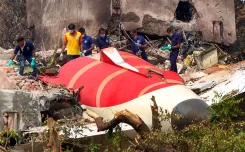Is the British F-35B Stealth Fighter Stranded at Thiruvananthapuram Airport?

Synopsis
Key Takeaways
- F-35B grounded for four days
- Emergency landing due to low fuel
- British engineers working on hydraulic issues
- Support from Indian authorities
- Significance for Indo-UK defense relations
Thiruvananthapuram, June 18 (NationPress) The British F-35B Lightning II stealth fighter jet, which made an unplanned landing at Thiruvananthapuram International Airport on Saturday night due to insufficient fuel, has now been grounded for four consecutive days as of Wednesday.
This aircraft, regarded as one of the most sophisticated stealth fighters globally, has attracted considerable interest from aviation fans and bystanders.
The F-35B is part of the UK's HMS Prince of Wales Carrier Strike Group, currently engaged in operations within the Indo-Pacific region. This carrier group had recently concluded joint maritime drills with the Indian Navy.
The jet was on its way back to the carrier when it experienced low fuel levels, necessitating an emergency landing.
Upon arrival, British aviation engineers have been diligently working to resolve a technical issue with the aircraft’s hydraulic systems. However, despite their dedicated efforts, the problem persists, further postponing the fighter jet’s return to its carrier. The aircraft remains stationed at Bay 4 of the airport, under strict security measures.
A Royal Navy helicopter arrived shortly after the landing, bringing a team of nine British aviation specialists, including a substitute pilot. The original pilot, who successfully landed the jet, has since returned via the helicopter.
The Indian Air Force, Airports Authority of India, and Kerala Police have provided comprehensive support to the British team, offering all necessary aid to facilitate repairs and ensure safety.
The F-35B is a fifth-generation multirole stealth fighter, notable for its short take-off and vertical landing (STOVL) capability, enabling it to operate from smaller runways and aircraft carriers without the need for catapult systems.
Its temporary stay in India is particularly significant, occurring just days after the Indian government approved the development of a prototype for the nation's fifth-generation fighter aircraft, marking a crucial milestone in India's defense and aerospace objectives.







